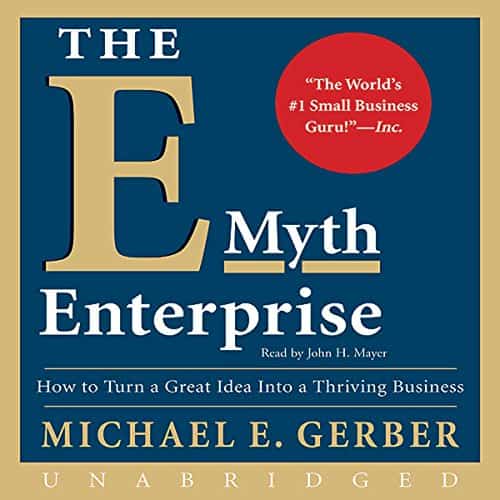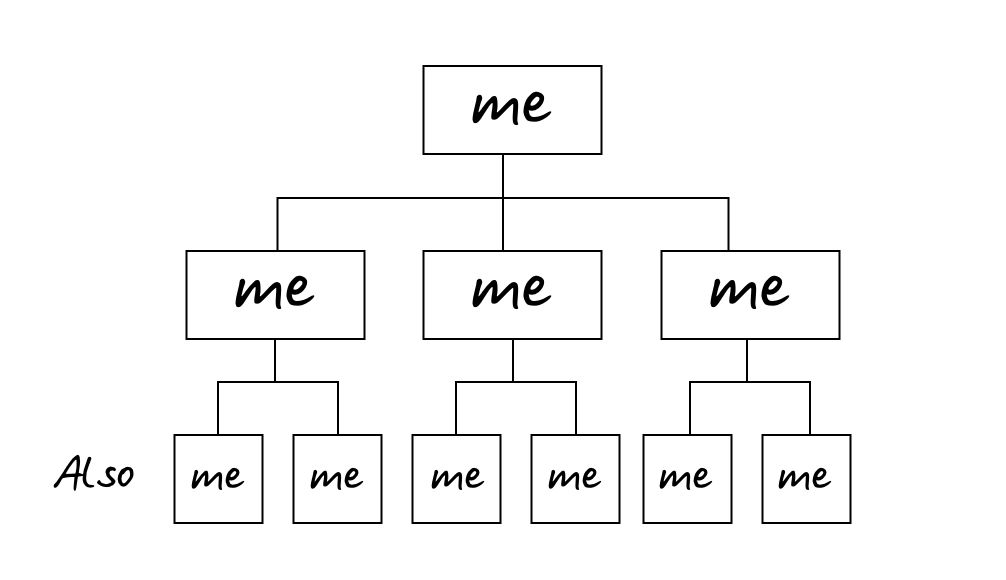The E-Myth Revisited by Michael Gerber | Book Summary
Within the first year of starting a business, at least 40 percent of these businesses fail. Then, within the first five years, more than 80 percent of these businesses will die.
In the book, The E-Myth Revisited, Michael Gerber discusses four powerful ideas of the entrepreneurial myth to help entrepreneurs grow into successful small business owners:
- The E-Myth is false, which states, “small businesses are started by entrepreneurs risking capital to make a profit.”
- The Turn-Key Revolution has changed how business is done, who goes into it, how they do it, and how likely they will survive.
- Within the Turn-Key Revolution, “the Business Development Process has the power to transform any small business into an incredibly effective organization.”
- This business model and development process can be applied to be “a predictable way to produce results and vitality in any small business.”
Buy The E-Myth Revisited on Amazon

The E-Myth Revisited by Michael Gerber
How to Turn a Great Idea Into a Thriving Business
Download the PDF Book Summary for The E-Myth Revisited
Part I: The E-Myth And American Small Business
The perpetuation of the E-Myth is why many small businesses fail today. You should understand the E-Myth and apply it to start and grow a successful business].
Chapter 1. The Entrepreneurial Myth
The Myth of the Entrepreneur is known as the E-Myth:
E-Myth – the myth “that small businesses are started by entrepreneurs risking capital to make a profit”
In your day job working for someone else, you become struck with the entrepreneurial seizure:
The Entrepreneurial Seizure – the thought that you can quit your job, be your own boss, and run your own business
And so, you fell prey to a fatal assumption made by all technicians that try to go into business:
The Fatal Assumption – “if you understand the technical work of a business, you understand a business that does that technical work,” but these are two totally different things:
- Technical Work of a Business – the application of technical knowledge and technical skills to perform specific tasks
- Business that does Technical Work – an organization that produces and sells goods and services for profit
The result is that “an entrepreneurial dream turns into a technician’s nightmare” by taking the work they enjoyed doing and turning it into a job.”
Chapter 2. The Entrepreneur, The Manager, And The Technician

The E-Myth Revisited argues that going into business depends on taking on these three personalities at once:
- The Entrepreneur – the leader who “defines the business and focuses on closing the gap between where the business is today and where they want it to be”
- The Manager – the supervisor who “focuses on achieving results through people and systems, focusing on the present and strategizing for the future”
- The Technician – the specialist who “lives in the present and is focused on doing the work of making it, selling it, and delivering it”
Ideally, the personalities would be balanced; however, the “typical small business owner is only 10 percent Entrepreneur, 20 percent Manager, and 70 percent Technician.”
Chapter 3. Infancy: The Technician’s Phase
The E-Myth Revisited states that small businesses are supposed to grow and change. However, most businesses operate “according to what the owner wants than what the business needs.”
There are three phases in a business’s growth, with the first phase being Infancy:
Infancy – “the start-up phase of your business when you act as a technician doing all the work of the business yourself”
Businesses in infancy are characterized by the owner and business being synonymous. You dedicate many personal resources to it, but it takes its toll. This stage ends when the owner understands that they can’t run the business this way forever and need help to learn and grow.
Chapter 4. Adolescence: Getting Some Help
The owner must be willing to change to survive and reach the second stage in business growth:
Adolescence – the growth stage of your own business when “you hire employees to take over some of the tasks that used to overwhelm you”
You hire technical help who has experience in your type of business, and it goes well at first. However, you later find that your employees are not as dedicated as you are and work is not getting done as you would like. As a result, you believe that you will produce the best work, sideline your employees, and insert yourself back into the technician role.
Chapter 5. Beyond The Comfort Zone
Within the Adolescent stage, owners are pushed to the limits of their comfort zone:
Comfort Zone – “the boundary within which he feels secure in his ability to control his environment, and outside of which he begins to lose that control;” for each personality:
- Technician’s Boundary – “determined by how much he can do himself”
- Manager’s Boundary – “defined by how many technicians he can supervise effectively or how many subordinate managers he can organize into a productive effort”
- Entrepreneur’s Boundary – determined by “how many managers he can engage in pursuit of his vision”
As a business grows, the business owner eventually becomes unable to control it and tries to promote managers. When the business grows beyond the owner’s Comfort Zone, it tends to go into a tailspin and leaves the owner with three possible choices
- Return to Infancy: The business reverts to a smaller, simpler entity when you did everything yourself, eventually becoming a job that owns you.
- Go for Broke: The business multiplies as customer demand outpaces its ability to produce until it catastrophically destructs under its own momentum.
- Survive in Adolescence: The business survives with you being consumed by working in it and the key idea of possibly losing it.
However, there is a better way of educating and preparing yourself for growth by establishing a business structure with processes, objectives, and strategies to handle the additional weight.
Chapter 6. Maturity And The Entrepreneurial Perspective
The E-Myth Revisited states that the best companies survive past adolescence and embody the third phase of business growth:
Maturity – the stage in which the “business knows how it got to be where it is, and what it must do to get to where it wants to go”
In Maturity, a successful business is founded on the entrepreneurial perspective:
Entrepreneurial Perspective – the business approach when one has “a clearly defined vision, with accountability standards and direction that drives the business to success”
Unlike the technician focused on the product or work, the business owner has a broader perspective of seeing the mature business as a product itself. The entrepreneur wants to satisfy the needs of a niche of customers innovatively, especially when compared to others in the marketplace.
Download the PDF Book Summary for The E-Myth Revisited
Part II: The Turn-Key Revolution: A New View Of Business
In the E-Myth Revisited, Michael Gerber states that the Turn-Key Revolution has changed how business is done, who goes into it, how they do it, and how likely they will survive.
Chapter 7. The Turn-Key Revolution
In 1952, Ray Kroc franchised the McDonald’s hamburger stand that ran “quickly, efficiently, inexpensively, and identically.” In under 40 years, McDonald’s grew to 28,707 restaurants worldwide and generated $40B per year.
This Turn-Key Revolution provided the Business Format Franchise, which can be used to build successful businesses:
Business Format Franchise – “provides franchisees with an entire system of doing business”
- Understand that “the true product of the business is the business itself,” and the customer is the franchisee.
- Create “a systems-dependent business, not a people-dependent business” that works without the owner being there.
Chapter 8. The Franchise Prototype
The success of Business Format Franchises is a result of the Franchise Prototype, which provides the system to make a great business operate and solve typical issues:
The Franchise Prototype – “a proprietary way of doing business that successfully and preferentially differentiates every extraordinary business from every one of its competitors:”
- Entrepreneur: Gives “the medium through which his vision takes form in the real world.”
- Manager: “Provides the order, the predictability, the system so important to his life.”
- Technician: Provides the freedom “to do the things he loves to do-technical work.”
If the franchise designs the business well, then the franchisee just needs to learn how to manage the system to achieve success. After learning the system, they get the key to operate:
Turn-Key Operation – the process of the franchisee getting “licensed the right to use the system, learn how to run it, and then turns the key” with the business doing the rest of the work
Chapter 9. Working On Your Business, Not In It
“Your business is not your life,” as they are two entirely separate things. “The purpose of your life is not to serve your business…the primary purpose of your business is to serve your life.” Once you understand this principle, you can implement the Franchise Prototype with these rules:
- Provide consistent value to your customers, employees, suppliers, and lenders beyond their expectations. “Value is what people perceive it to be, and nothing more.”
- Design for those with the “lowest possible level of skill” to operate their specific function. People that follow your systems will allow you to replicate and scale.
- Design to model to have impeccable order as “structure provides the relatively fixed points of reference that we need.” Without structure, your business will fall into chaos.
- Document all work with a company Operations Manual. For each task, documentation should provide the purpose, steps, and standards for the process and result.
- Provide “a uniformly predictable service to the customer.” Provide the same experience to your customers every time.
- Use a “uniform color, dress, and facilities code.” Marketing studies show that consumers pay attention to firms’ appearance (colors and shapes) in the market.
Thus, you need to work on, not in, your business to create a systematized process. Within the rest of the book, the author presents his proven methodology, the E-Myth Mastery Program.
Part III: Building a Small Business That Works!
Download the PDF Book Summary for The E-Myth Revisited
Chapter 10. The Business Development Process
In the E-Myth Revisited, Michael Gerber shows your how to build and adapt your business through the following habitual continuous process:
Business Development Process – the process by which a business naturally evolves through these three significant activities:
- Innovation – “the mechanism through which your business identifies itself in the mind of your customer and establishes its individuality” by constantly determining the best way
- Quantification – the process of establishing “numbers related to the impact [and value] an innovation makes;” the metrics or KPIs provide a pulse and indicate future performance
- Orchestration – “the elimination of discretion, or choice, at the operating level of your business,” which results in a consistent process and product
Chapter 11. Your Business Development Program
Your business should structure as a Franchise Prototype to be easy to sell. In the E-Myth Revisited, Michael Gerber shows you how to create this entrepreneurial model using the following program:
Business Development Program – the seven distinct steps in a process that transforms your new or existing business into a Franchise Prototype that can be replicated and scaled:
- Your Primary Aim
- Your Strategic Objective
- Your Organizational Strategy
- Your Management Strategy
- Your People Strategy
- Your Marketing Strategy
- Your Systems Strategy
Chapter 12. Your Primary Aim
In the E-Myth Revisited, Michael Gerber argues that your business should not be your life, but it can play a significant role. To figure out that role, you should establish Your Primary Aim:
Your Primary Aim – “the vision necessary to bring your business to life and your life to your business,” which provides you with a purpose, energy, and a source of profit; develop it by asking yourself the following questions for your life:
- Values: What do I value most? Who do I wish to be?
- Lifestyle: What kind of life do I want? What do I want my life to look like, to feel like?
- Ideal Day: How do I want my life to be like on a day-to-day basis?
- People: What role will I play with other people in my life, including my family, friends, community, business partners, employees, and clients?
- Reputation: How would I like people to think about me?
- Timeline: Where do I want to be in a year, five years, ten years, 20 years, and so on?
- Growth: What do I want to learn during my life in terms of spirituality, health, finances, skills, knowledge, and relationships?
- Finances: How much money is required for my lifestyle? When do I need it by?
The answers are the standards by which you should live your life by and measure progress. Without standards, you will be wandering without any purpose or meaning.
Chapter 13. Your Strategic Objective
After figuring out your life vision in terms of Your Primary Aim, you can focus on developing your business in terms of Your Strategic Objective:
Your Strategic Objective – “a very clear statement of what your business has to ultimately do for you to achieve your Primary Aim;” this business strategy and plan provides these standards:
- Money: How much do I need and want?
- Lifestyle: How much money do I need to live my ideal life?
- Sell Your Business: How much do I want my business to be worth?
- An Opportunity Worth Pursuing: Does my business fulfill my financial standards set within my Primary Aim and my Strategic Objective?
- Type of Business: What feeling (product) is your customer buying from you?
- Customer Avatar: Who is your customer regarding demographics (who your customer is) and psychographics (why your customer buys)?
- Other Standards: Here are some other stands that you can include:
- When will your prototype be finished? How many years?
- Where will you be in business? Local, regional, national, or global?
- How will you be in business? Retail, wholesale, or both?
- What additional standards will you have? These standards may include metrics, safety, cleanliness, management, human resources, and so on.
In the E-Myth Revisited, Michael Gerber states to set appropriate standards to help your people be more productive and deliver consistently. Further, every morning, you should eat that frog or work toward your Strategic Objective, so you can grow your business.
Chapter 14. Your Organizational Strategy

First, think of your business, regardless of the number of partners, as a corporation with:
- Shareholders: These are owners having roles outside the business.
- Employees: These are the people working inside the business.
Avoid organizing around personalities. Instead, you should organize your business and people around accountabilities and responsibilities by creating an Organizational Chart:
Organizational Chart – a diagram that shows your company’s internal structure by detailing the roles, responsibilities, and relationships between the employees
Build the business starting from the tactical work of the technicians. For each company role, establish a position contract to provide accountability and include the following:
- “The results to be achieved by each position in the company,
- The work the occupant of that position is accountable for,
- A list of standards by which the results are to be evaluated, and
- A line for the signature of the person who agrees to fulfill those accountabilities.”
Chapter 15. Your Management Strategy
Instead of hiring management degrees, you can implement a great management strategy yourself:
Management System – “a system designed in your prototype to produce a marketing result… that finds and keeps customers–profitably–better than any other”
To be an effective Franchise Prototype, the system should be automatic through this process:
Management Development – “the process through which you create your Management System and teach your up-and-coming managers to use it”
You should manage by creating and executing work in an Operations Manual. Within it, each role should have checklists to itemize the steps that your employees need to do their work, hold them accountable, and standards for performance. For more regarding checklists, check out The Checklist Manifesto (book summary).
Chapter 16. Your People Strategy
Take your people seriously and communicate that “the work we do is a reflection of who we are. Work is an opportunity to succeed, which will bring life to the work we do. Have your people understand that the “idea behind the work that was more important than the work itself:”
- “The customer is not always right, but whether he is or not, it is our job to make him feel that way.”
- “Everyone who works here is expected to work toward being the best he can possibly be at the tasks he’s accountable for. When he can’t,” he should try to improve or leave.
- “The business is a place where everything we know how to do is tested by what we don’t know how to do, and that the conflict between the two” creates growth and meaning.
The business serves your employees to perform at their best, and they will look to you for how to act. Therefore, the best firms establish “a game to be played in which the rules symbolize the idea you, the owner, have about the world” with rules that must be honored to perform:
- Never determine what you want your people to do and then try to create a game out of it.
- Never establish a game for your employees you are unwilling to play yourself.
- Ensure there are particular ways to win the game without ending it.
- Modify the game every so often, precisely the tactics, not the strategy.
- Never expect the game to be sustainable, as people should be reminded of it constantly.
- The game should make sense.
- The game should be enjoyable from time to time.
- If you are unable to create a good game, steal one.
A “Game Worth Playing” provides the purpose, values, and standards to live life well and perform at work. You should communicate ideas to your people through documented systems and in an orderly, human manner. Specifically, the hiring process will allow you to establish a proper relationship to develop and retain people to succeed within your business.
Chapter 17. Your Marketing Strategy
The E-Myth Revisited tells you to build a successful marketing program by focusing on what your customer wants. “What your customer wants is probably significantly different from what you think he wants.”
There are two parts to a great Marketing Strategy:
- Demographics – “the science of marketplace reality” showing “who your customer is”
- Psychographics – “the science of perceived marketplace reality” indicating “why your customer buys”
Determine your customer’s demographics by getting them to complete a survey, questionnaire, or another marketing tool. After determining these, you can “construct a Prototype to satisfy his unconscious [or psychographic] needs, but scientifically rather than arbitrarily.”
Chapter 18. Your Systems Strategy
Finally, within the E-Myth Revisited, Michael Gerber defines what a system is:
System – “a set of things, actions, ideas, and information that interact with each other, and in so doing, alter other systems”
Everything can be observed as a system, and three major systems need to be fully integrated for your business:
- Hard Systems: The hard systems are inanimate, unliving things, such as colors, computers, and whiteboards.
- Soft Systems: The soft systems animate, living things or ideas, such as scripts, the sales process, and your employees
- Information Systems: The information systems “those that provide us with information about the interaction between the other two,” such as reporting metrics, controlling inventory, and forecasting
In the E-Myth Revisited, Michael Gerber emphasizes using a Sales System to increase sales:
Sales System – the six-step rehearsed interaction between you and your customers:
- Identify the specific benchmarks or prospect decision points within the sales process.
- Literally, script the words that will successfully get you the sales.
- Create the various materials to be used with each sales script.
- Memorize the script for each benchmark.
- Have your salespeople deliver the script in an identical manner.
- Have them communicate effectively by listening and engaging every prospect fully.
At E-Myth Worldwide, their PowerPoint Selling System focuses on structure (what you do) and substance (how you do it). The system requires setting an appointment, conducting a needs analysis, and providing a solution to the customer.
Check out the Entrepreneurial Operating System, for more on building systems in your business.
Download the PDF Book Summary for The E-Myth Revisited
Concluding Chapters
Throughout the E-Myth Revisited, Michael Gerber uses the story of Sarah, an entrepreneur in the pie-making business, as an example and case study. He leaves her with one main piece of advice: “keep the curtain up.” The curtain is an analogy to protect your entrepreneurial spirit from your comfort zone, making you feel safe and unable to take risks.
Gerber also discusses that you cannot change a world that is chaotic and disorderly. “If the world is going to be changed, we must first change our lives.” And so, the process of creating and growing a business will bring about change in the people who engage in it, so get started!
Next Steps
In the book, The E-Myth Revisited, Michael Gerber tears down the myths of becoming an entrepreneur. He discusses the lifecycle of a business, the underlying processes and systems, and how to apply the lessons of franchising to succeed.
I hope The E-Myth Revisited summary has inspired you to get your copy of the book. For more on how to implement an operating system in your business, check out Traction (book summary). For a book on incorporating entrepreneurship into your life, check out The EOS Life (book summary).







